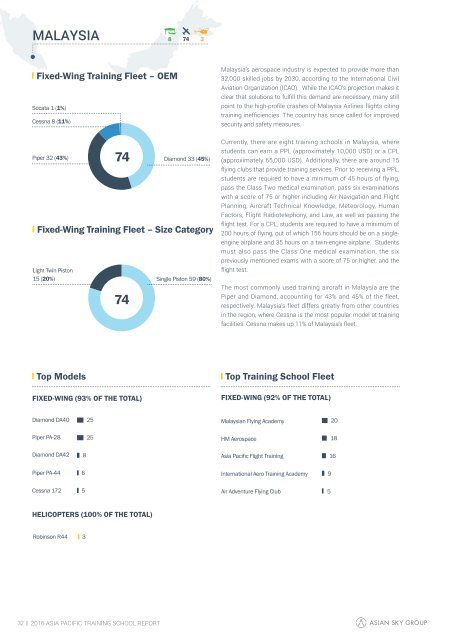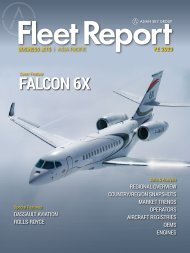You also want an ePaper? Increase the reach of your titles
YUMPU automatically turns print PDFs into web optimized ePapers that Google loves.
MALAYSIA<br />
8 74<br />
3<br />
Fixed-Wing <strong>Training</strong> Fleet – OEM<br />
Socata 1 (1%)<br />
Cessna 8 (11%)<br />
Piper 32 (43%)<br />
Fixed-Wing <strong>Training</strong> Fleet – Size Category<br />
Light Twin Piston<br />
15 (20%)<br />
45+43+11+1+G<br />
74<br />
80+20+G<br />
74<br />
Diamond 33 (45%)<br />
Single Piston 59 (80%)<br />
Malaysia’s aerospace industry is expected to provide more than<br />
32,000 skilled jobs by 2030, according to the International Civil<br />
Aviation Organization (ICAO). While the ICAO’s projection makes it<br />
clear that solutions to fulfill this demand are necessary, many still<br />
point to the high-profile crashes of Malaysia Airlines flights citing<br />
training inefficiencies. The country has since called for improved<br />
security and safety measures.<br />
Currently, there are eight training schools in Malaysia, where<br />
students can earn a PPL (approximately 10,000 USD) or a CPL<br />
(approximately 65,000 USD). Additionally, there are around 15<br />
flying clubs that provide training services. Prior to receiving a PPL,<br />
students are required to have a minimum of 45 hours of flying,<br />
pass the Class Two medical examination, pass six examinations<br />
with a score of 75 or higher including Air Navigation and Flight<br />
Planning, Aircraft Technical Knowledge, Meteorology, Human<br />
Factors, Flight Radiotelephony, and Law, as well as passing the<br />
flight test. For a CPL, students are required to have a minimum of<br />
200 hours of flying, out of which 156 hours should be on a singleengine<br />
airplane and 35 hours on a twin-engine airplane. Students<br />
must also pass the Class One medical examination, the six<br />
previously mentioned exams with a score of 75 or higher, and the<br />
flight test.<br />
The most commonly used training aircraft in Malaysia are the<br />
Piper and Diamond, accounting for 43% and 45% of the fleet,<br />
respectively. Malaysia’s fleet differs greatly from other countries<br />
in the region, where Cessna is the most popular model at training<br />
facilities. Cessna makes up 11% of Malaysia’s fleet.<br />
Top Models<br />
FIXED-WING (93% OF THE TOTAL)<br />
Top <strong>Training</strong> School Fleet<br />
FIXED-WING (92% OF THE TOTAL)<br />
8+0+8+0+3+0+2+0+2<br />
Diamond DA40 25<br />
Piper PA-28<br />
Diamond DA42<br />
Piper PA-44<br />
Cessna 172<br />
8<br />
6<br />
5<br />
25<br />
HELICOPTERS (100% OF THE TOTAL)<br />
Malaysian Flying Academy 20<br />
HM Aerospace<br />
Asia Pacific Flight <strong>Training</strong><br />
International Aero <strong>Training</strong> Academy<br />
Air Adventure Flying Club<br />
7+0+6+0+5+0+3+0+2<br />
18<br />
16<br />
9<br />
5<br />
1<br />
Robinson R44 3<br />
32 | 2016 ASIA PACIFIC TRAINING SCHOOL REPORT

















